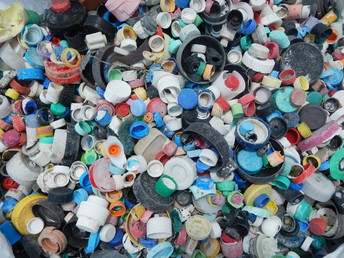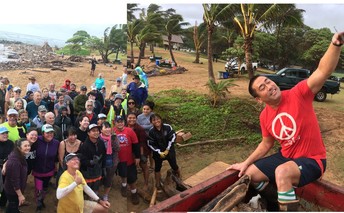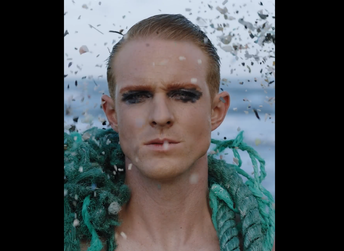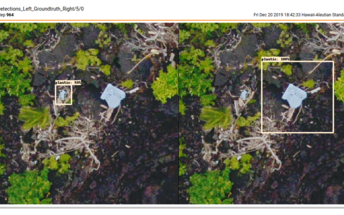| Header Photo: Derelict fishing nets recovered from the Papahānaumokuākea Marine National Monument (Photo credit: NOAA).
 Two juvenile green sea turtles freed from an illegal gill net found in the nearshore waters of central Maui, NOAA Permit: 21260 (Photo credit: Maui Ocean Center Marine Institute).
Submitted by: Thomas Cutt, Maui Ocean Center Marine Institute
In partnership with NOAA Fisheries, Maui Ocean Center Marine Institute (MOCMI) responds to reports of sick, injured, distressed, and expired sea turtles on the island of Maui. Among the 141 confirmed strandings in 2019, 74% were due to interactions with recreational fishing gear. Entanglement in monofilament fishing line was the leading documented threat to sea turtles on Maui in 2019 and juvenile greens sea turtles were most often impacted. Learn more about MOCMI’s findings in the Sea Turtle Stranding Response & Rescue: 2019 Summary of Results document, here.
 The newly installed water bottle filling station at Wailoa Center in Hilo (Photo credit: Megan Lamson).
Submitted by: Dena Sedar, Hawaii State Parks
In November 2019, Hawaii State Parks celebrated the installation of a water bottle filling station at Wailoa Center in Hilo, Hawaii with the Help Keep the Sea Plastic Free art event. Community members had the opportunity to create art out of marine debris collected from Kamilo Point and fill up their reusable water bottles. To illustrate the issue of marine debris in the Hawaiian Islands, the lava rock fountain at the center was covered in derelict nets and marine debris. The art event and fountain decoration helped to drive home the idea that even small steps, like using refillable water bottles, can help prevent marine debris in our islands.
 A recently installed finishg line recycling bin at Makai Research Pier (Photo credit: NOAA).
Submitted by: Mark Manuel, NOAA Marine Debris Program
In line with HI-MDAP action 3.4.7 and building off of the success of MOCMI’s Fishing Line Recycling Program, the Hawai‘i Fishing Line Recycle Bin Program will soon be established on O‘ahu and will expand to additional islands in the future. If you are interested in adopting a bin, please contact Mark Manuel at mark.manuel@noaa.gov.
 The Plastics Source Reduction Working Group has been newly created by way of SB522 SD2 HD2 CD1 and Act 254 (19) of the 2019 Legislative Session (Photo credit: NOAA).
Submitted by: Clifford Inn, Hawaii State Department of Land and Natural Resources, Division of Boating and Ocean Recreation
The Plastics Source Reduction Working Group has been newly created by way of SB522 SD2 HD2 CD1 and Act 254 (19) of the 2019 Legislative Session. The Working Group has six goals, the first two of which are: 1) to formulate a plan for reducing and recovering plastic from the Hawaii waste stream, and 2) develop strategies to encourage plastic reduction and reuse in the food industry. The working group membership is diverse, with representation from Surfrider Foundation, Zero Waste Oahu, Sustainable Coastlines, all Counties, the recycling industry, Hawaii Tourism Authority, and DLNR among others. The Working Group may try to amplify its efforts by working in concert with other groups that have similar goals.
Learn more
 Mayor Derek Kawakami posed for a selfie early in the community work day as volunteers packed a 30-yard roll-off container with driftwood for composting; by the end of the session, the tidal zone was about 85% free of driftwood (Photo credit: Scott Lever).
Submitted by: Thomas Noyes, The Friends of Kamalani and Lydgate Park
Kaua‘i’s Lydgate Beach Park is unique. In the mid-1960s Līhuʻe Plantation built a seawall creating a protected swimming area, the Wailua River flows into the ocean nearby, and in 1994 Friends of Kamalani and Lydgate Park volunteers built a wonderful playground. Volunteers devote 5,000+ hours annually taking care of the park, including clearing marine debris that washes into the swimming pond. On January 11, 2020 about 100 volunteers turned out for a beach cleanup to clear a mass of albezia driftwood mixed with plastic marine debris.
Learn more
 HWF environmental education mentor, Brianna Craig, brings a team of students from Hana High School for a Kainalimu Bay cleanup, funded in-part by a NOAA Planet Stewards award (Photo credit: B. Craig).
Submitted by: Megan Lamson, Hawai‘i Wildlife Fund
Hawai'i Wildlife Fund (HWF) is stoked that in 2019 we removed over 41 tons of marine debris from three islands with help from 1,760 volunteers. These efforts included 70 cleanups on Hawai‘i Island, 10 on Maui, and 1 on Lāna‘i with help from friends, including Love the Sea, Pūlama Lāna‘i, Sustainable Coastlines Hawai‘I, and various Surfrider Chapters. We are MORE excited that we reached over 841 students in 13 schools on Hawai‘i and Maui with our environmental education programs and outreach groups. We are inspired by the youth-led #FridaysForFuture rallies around the world demanding climate action and plastic reduction locally and globally. IMUA keiki!
 Middle school students participated in two beach cleanups, removing over 2,000 lbs of nets and plastics (Photo credit: Surfrider Kaua‘i).
Submitted by: Barbara Wiedner, Surfrider Foundation Kaua'i Chapter
Two teachers from Waimea Canyon Middle School were recently awarded an Innovation Grant through the Hawaii Department of Education for almost $7,000 to focus on marine debris issues on Kaua'i. Alex Nelson and Beth Kauwe are working with 40 middle schoolers to "Keep Kaua'i Marine Debris Free" through organizing beach cleanups, building sand sifters, and creating artwork and a documentary. Waimea Canyon Middle School will continue to partner with Surfirder Foundation for cleanups as they did last month. 140 students did two beach cleanups which removed over 2,000 lbs of nets and plastics off of the beach at Nukoli'i and Māhāʻulepū.
 The documentary followed Pattie Gonia throughout Hawai'i to learn about plastic pollution in the islands (Photo credit: REI).
Submitted by: Jennifer Lynch, NIST; Center for Marine Debris Research
Pattie Gonia, an environmentalist drag queen, visited Hawai'i to learn about plastic pollution. REI sponsored the making of a stunning music video and a documentary that featured Sustainable Coastlines Hawaii and the Hawai'i Pacific University Center for Marine Debris Research. The reach has been far and wide; the music video, “Everything to Lose,” has viewed 2.8 million times and the “Story Behind Everything to Lose” has been watched by over 708,000 people.
 After training a computer model, the model identified a new piece of debris with 59% accuracy, while a piece of training data from that image is shown on the right (Photo credit: Ross Winans).
Submitted by: Miguel Castrence, Resource Mapping Hawaii
Project team members Ross Winans and Katie Taladay attended Microsoft’s AI for Earth Summit in October 2019 to learn about machine learning (ML), cloud computing, and an online tool for citizen science, making it easier for citizen scientists to catalog and report marine debris. We’ve developed two ML models: a classifier and an object detector. This 2-step strategy offers both computational savings as well as better classification results. The classifier has 75-80% accuracy, while the object detector has lower validation accuracies of 55-60%. As our grant expires this month, we requested a 12-month extension to continue fine-tuning, improve accuracy through citizen science, and create a public-facing online tool for users to submit UAS or other imagery for analysis.
 |